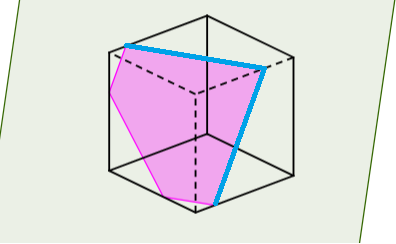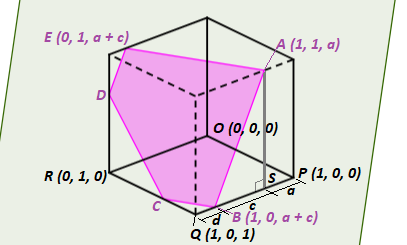Cross section of a cube and a plane (part 2)
Last week , we saw how a cube can be sliced such that the cut is a regular hexagon.
Is it possible to make a cut that is a regular pentagon ?
This section requires Javascript.
You are seeing this because something didn't load right. We suggest you, (a) try
refreshing the page, (b) enabling javascript if it is disabled on your browser and,
finally, (c)
loading the
non-javascript version of this page
. We're sorry about the hassle.
4 solutions
I feel like this question is kind of bullshit. Nowhere does the question say it has to be a regular cut or only one cut, and without those rules, you can turn a cube into anything you want.

For the plane section to make a pentagon, two of the sides of the cube must be cut as shown in blue. They intersect opposite sides of the square. The angle between these segments must be acute.
A regular pentagon has all angles greater than 90 degrees. Therefore the pentagon cannot be regular.
So simple. Beautiful!
Log in to reply
Thank you. I was playing around with the side lengths composing a proof like your when it hit me: what about the angles?
A picture can be demonstrative, but I don't see how it can be exhaustive. Why must "two of the sides of the cube be cut as shown in blue"? What property of these sides are you referring to? What distinguishes these two sides from any other pair of adjacent sides? "They intersect opposite sides of the square." What square? No square is part of this problem. It's about slicing a cube with a plane.
"The angle between theses segments must be acute." Why?
I don't mean to be harsh. I'm trying to understand how you are forcing an acute angle. Why must this angle be acute when the angles adjacent needn't be?
Log in to reply
Any plane section that will form a hexagon must pass through all 6 sides of the cube, as in the original problem. Notice how each square side of the cube has just a corner cut off - the cut passes through consecutive sides of the square. The angles of the section itself can be very wide. Wide enough to make the 120-degree angles of a regular hexagon.
Any plane section that will form a pentagon must pass through only 5 of the 6 sides of the cube. So the plane has to be pulled forward a bit to not hit one side. See how the blue lines don't reach far enough to hit the sixth side. These lines pass through opposite sides of the square faces.
These two lines have an angle of between 60 and 90 degrees.
As given by the author's solution, the picture below shows that it is possible for the cross-section to be a pentagon. (Some labels and coordinates were added for the proof below.)

We can show that the pentagon cannot be regular by an indirect proof:
Assume that the cross-sectional pentagon A B C D E is regular. Then A B = B C = C D = D E = A E . Let the cube be a unit cube, and let A be a away from one of the cube's vertices. Then since A B = A E , and B and E must also be the same distance away from some of the other cube's vertices, and let that distance B P = a + c . (Let the distance from B to the other cube's vertex Q be B Q = d . As a unit cube, a + c + d = 1 .) Then the coordinates for A , B , and E are A ( 1 , 1 , a ) , B ( 1 , 0 , a + c ) , and E ( 0 , 1 , a + c ) , and vector A B = ( 0 , − 1 , c ) and vector A C = ( − 1 , 0 , c ) , and the equation of the cross-sectional plane is c x + c y + z = a + 2 c .
Since C is the plane y = 0 , z = 1 , and c x + c y + z = a + 2 c , its coordinates are C ( 1 − c d , 0 , 1 ) . Since D is the plane x = 0 , z = 1 , and c x + c y + z = a + 2 c , its coordinates are D ( 0 , 1 − c d , 1 ) . Then D R = 1 − c d , C R = 1 − c d , and as a unit cube, C Q = c d .
Now, by Pythagorean's Theorem on △ A S B , A B = c 2 + 1 , and by Pythagorean's Theorem on △ B Q C , B C = d 2 + c 2 d 2 = c d c 2 + 1 . Since A B = B C , c 2 + 1 = c d c 2 + 1 , which means c d = 1 . But then C R = 1 − c d = 0 and D R = 1 − c d = 0 , and by Pythagorean's Theorem on △ C R D , C D = 0 , which means A B = B C = C D = D E = A E = 0 , so there is no pentagon, which is absurd. Therefore, our assumption that the cross-sectional pentagon A B C D E is regular is false, which means pentagon A B C D E cannot be a regular pentagon.
[Partial Solution]
The above figure shows that it is possible to have a pentagon.
I hope to see insightful solution, to show it is not possible to have regular pentagon, from you.
The plane containing the pentagon must intersect 5 cube's faces from which 2 pairs are parallels. The intersection of a plane with 2 parallels plane is 2 parallels lines. So the pentagon has 2 pairs of parallels edges and could not be regular.